Guidelines on remediation of contaminated sites
9. Remedial Measures
This chapter is structured so that the ‘contamination media’ represent the three main sections (soil contamination, groundwater contamination, soil gas/gas contamination). As far as possible, the main sections are subdivided into remediation techniques for the individual media. Rapid developments are currently taking place in remedial methods, and therefore distinctions will be made between well-proven methods and new methods. Further assistance in selecting remedial techniques can be found in Appendix 9.1 which includes a table with costs, advantages, and disadvantages for each remedial measure, as well as the contamination components which can be treated with each method. The extent to which a given remedial measure can be applied at a specific location depends on a number of location-specific factors. Therefore, the choice of method should be closely linked to evaluation of operation and evaluation of the completed measures, cf. Chapter 10.
At the present time, rapid developments in remedial techniques are taking place. Information on alternative remediation technologies is therefore extensive. In addition, the Internet is a new source of knowledge which will be used increasingly in the future. Current addresses which are relevant, e.g. US-EPA (Hazard waste clean-up information) which have the following path http://clu-in.com (March 1997) or the Danish ‘grundvand på Internettet’: http://inet.uni-c.dk/-nnr-vm/ (March 1997), have many relevant ‘links’ to other addresses.
9.1 Clean-up objectives
If the risk assessment (see Chapter 5) concludes that there is a health risk in relation to land use, indoors or out, or that the groundwater or recipients are threatened, then remedial measures should be implemented.
9.1.1 Remedial measures in relation to land use
Remedial measures in relation to land use should aim at removing or cutting-off contamination, and preventing or reducing exposure.
This can be achieved through the following remedial strategies:
| Excavation of the contaminated soil with subsequent off-site (ex-site) or on-site treatment. | |
| In-situ treatment of soil and groundwater. | |
| Pumping groundwater near the surface. | |
| Construction measures for reducing indoor air exposure to volatile contaminants. | |
| Equipment to prevent or reduce exposure in the outdoor environment, and to prevent contamination from spreading /14/. |
Furthermore, exposure can be reduced by changing or adapting land use to the actual conditions.
9.1.2 Remedial measures for groundwater and recipients
Remedial measures for the groundwater and recipients aim at reducing or preventing spread to the groundwater aquifer and recipients.
This can be achieved through the following remedial strategies:
| Excavation of the contaminated soil with subsequent off-site (ex-site) or on-site treatment. | |
| Active in-situ treatment of soil and groundwater. | |
| Pumping strategies with possible subsequent water treatment. | |
| Immobilisation of the contaminants (sealing, stabilisation, capping, cutting-off, fixing, vitrification). |
9.2 Remedial measures for soil contamination
9.2.1 Overview of remedial methods
Developments in remedial methods are moving rapidly. There is a lack of documentation of the effects under Danish conditions for many of the new methods. This overview is therefore divided into well-tried methods and methods with potential application in Denmark.
There is a distinction between in-situ, on-site, and off-site (ex-site) methods. The following remedial methods have been started and completed for soil contamination in Denmark /31, 32/:
| Excavation and disposal of soil at central treatment facilities (ex-site). | |
| Excavation and soil disposal at landfills (ex-site). | |
| Excavation and soil disposal at treatment facilities (on-site). | |
| Soil vapour extraction (in situ). | |
| Forced leaching (in-situ). | |
| Methods using construction techniques and equipment (on-site, in-situ). |
Furthermore, there are remedial techniques which have not been fully tested, but which have varying potential in Denmark. The following can be mentioned /31, 32/:
| Bioventilation | |
| Biological soil treatment (inoculation technique) | |
| Detergent leaching | |
| Immobilisation (vitrification, stabilisation) | |
| Electrokinetics | |
| Steam stripping | |
| Chemical treatment | |
| ‘Pneumatic fracturing’ |
Method selection depends on many factors, e.g. type of contamination, location of contamination, soil type, geology and hydrogeology, time available for clean-up, effect of clean-up and acceptable residual contamination, land use and lay out, working environment during remedial measures, costs of the methods, and last but not least, documentation of the methods application. Furthermore, the environmental effects should be assessed so that the best environment is achieved for the resources invested. It is assumed that all the remedial measures proposed eliminate the identified risks.
In addition to the descriptions below, the review of remedial methods has been collected and simplified in a chart in Appendix 9.1, where examples of costs for each method are also displayed.
9.2.2 Excavation
Excavation is by far the most common remedial method in the case of soil contamination. The contamination is removed, usually by an excavator, under controlled conditions, until the sides and bottom of the excavation are sufficiently clean. This is determined by the acceptance criteria for the specific contamination, which must be met at the completion of excavation work, cf. assessments described in Chapters 5 and 6.
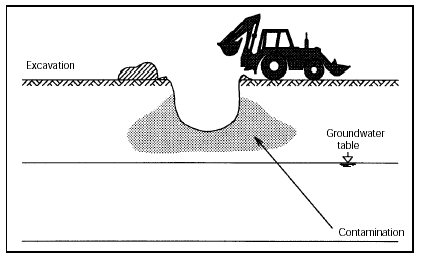
Figure 9.1
Excavation of soil contamination
In order to ensure the stability of buildings etc. the foundation norm (DS 415) must also be followed in all excavation work /33/. An example of how this is done in practice is described in Appendix 9.2.
The criteria for excavation must be documented using analyses of soil samples taken from the sides and bottom of the excavation. For excavation, the operation and evaluation phase occurs simultaneously with the remediation phase. The method is described in more detail in Chapter 10. In order to ensure that the requirements are complied with, the excavation must be supervised by environmental experts. This supervision is described in Section 8.5.
Until the early 1990’s, there was no real alternative to excavation which explains why the method is still the most widely used method today. The advantage of the method is that it is quick and well documented. More or less all completed remedial projects for soil contamination have been carried out with the help of excavation. Furthermore, excavation is applicable for all types of soil and contamination. The disadvantages of the method are the resulting environmental effects.
9.2.3 Treatment methods for excavated soil
Since 1990, local authorities have been responsible for assigning the disposal of all industrial and commercial waste, including contaminated soil and contaminated construction waste (oil separators, tanks, foundations etc.). With regard to disposal, soil is often subdivided into classes of contamination /34/.
There are several central soil treatment facilities, most of which treat soil contaminated with organics by microbiological degradation (stack composting or land farming). If there is a significant heavy metal, cyanide, or tar content, thermal treatment for, e.g. tar products, is possible at some treatment facilities or at various power stations. Chemical extraction (carried out by a single firm in 1997) treats soil for tar, pesticides, cyanides, and heavy metals in addition to lighter contamination. Finally, there is the possibility of landfilling heavy metals, for example. Stripping of highly volatile contamination is only applied to a very limited extent.
Contaminated soil can be landfilled. Landfilling can, however, only take place if it is authorised by both supervision authorities at the landfill site, and the local authority from where the contaminated soil originated.
Some soil treatment firms offer to treat excavated soil on-site using the same principles as central plants (land farming and, to a lesser extent, stack composting). Furthermore, on-site mobile treatment equipment (thermal methods, stripping, soil rinsing, etc.) has been tested to a very limited extent /31/. Finally, forced leaching has been tested at a single site (water is percolated through the contaminated soil, enclosed in membranes. The water is cleaned and recirculated) /31/.
Experience of methods in Denmark is not exhaustive. Completed projects indicate that methods require large amounts of soil before they become attractive, and they require generally sandy soil and lighter organic contamination. The disadvantages of the methods include space requirements, expensive construction requirements (e.g. leachate collection systems), extensive time requirements, whether excavations may remain unfilled for longer periods, and odour and noise problems.
9.2.4 Soil vapour extraction
Soil vapour extraction is primarily a physical removal (stripping) of highly-volatile xenobiotic organic substances from the unsaturated zone using a vacuum. This method is the most frequently applied in-situ method in Denmark.
A number of active ventilation screens are installed in the unsaturated zone, and they are subjected to a vacuum using a ventilator. Highly volatile substances are in this way sucked out of the soil. In some cases, passive screens can be more appropriate in order to control the air flow (particularly for contamination under buildings).
Depending on the type and concentration of contamination, it is often necessary to clean the extracted air, usually using carbon filters. If there is benzene at the site, such cleaning should usually be performed because of the low air-quality criteria for this substance.
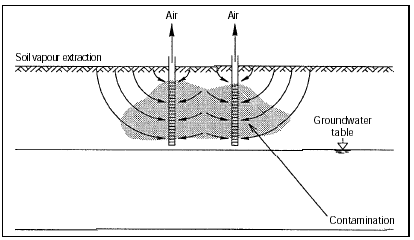
Figure 9.2
Soil vapour extraction
Soil vapour extraction is most appropriate for remediation of highly volatile organic contamination in looser soil types. In order to design soil vapour extraction properly, air-permeability tests should always be performed /35/, and bio-activity tests can also be of assistance. Bio-activity tests can document the potential for biodegradation as well as assist in determining the distance between the extraction drillings (radius of influence). The location of the contamination can be decisive in choosing this method, as this method is well suited to contamination which lies close to, or under, buildings. The time required to remediate can vary depending on the soil conditions, the type of contamination, and the stop criteria (typically from five months to several years). Many remediations of this type have been completed and approved in Denmark (1997). This method requires that stop criteria and evaluation methods are set from the outset, cf. Chapter 10.
9.2.5 Treatment methods for extracted air
Normally, the extracted air must be treated before emission. Permitted emission levels appear in ‘Orienteering’ No. 15, 1996, from the Danish EPA /11/. The following treatment methods are typically used for extracted air:
| Granular active carbon (GAC) | |
| Catalytic oxidation | |
| Direct incineration | |
| Biological filters |
It is most common to use activated carbon filters to treat the extracted air before it is emitted. The advantages of a activated carbon filters are that the method is easy and safe, both for small air flows and high concentrations. Furthermore, purchase of the equipment is relatively inexpensive. On the other hand, the equipment is expensive to operate, and there are often noise problems. Activated carbon filter equipment also requires a lot of supervision, particularly at the start where carbon must be changed frequently. Finally, it is important to note that the effect depends on temperature and the composition of the contamination.
Catalytic oxidation is cheap to operate as the method is self-controlled and removal takes place with no critical by-products. On the other hand, purchase of the equipment is expensive and the method requires high concentrations of contaminants.
As with the catalytic method, purchase of biological filter equipment is expensive, but operation is inexpensive. On the other hand, this method is relatively sensitive in operation. Direct incineration is also expensive.
9.2.6 Bioventilation
Bioventilation is the aerobic microbial degradation of xenobiotic organic substances in the unsaturated zone, for example through the addition of atmospheric air or oxygen. A number of bioventilation screens are installed in the unsaturated zone. Air is blown in using a ventilator, and decomposition of the contamination is stimulated. Usually, a number of passive ‘air-emission screens’ are located at appropriate distances depending on the characteristics of the contamination. Bioventilation stimulates biodegradation by blowing in air, unlike soil vapour extraction where contamination components are sucked out of the soil.
Projects regarding bioventilation have been approved and are in operation in Denmark, but as yet, there is no knowledge of completed remediation in Denmark (1997). The USA has performed many remediations using this method. It seems that the method is best suited to remediation of lighter, aerobically degradable organic contaminants (mineral-oil products and solvents, but not chlorinated solvents) in permeable soil types. The method is also most suitable for substances with a low to moderate vapour pressure. Otherwise, there is a risk that the substance will be stripped before it is degraded. Air permeability tests and bioactivity tests should be performed when designing the equipment, with a view to ascertaining the air flow and the degradation potential of the site /35, 36/.
The location of the contamination is significant. For example, this method should be considered where contamination is located under or close to a building.
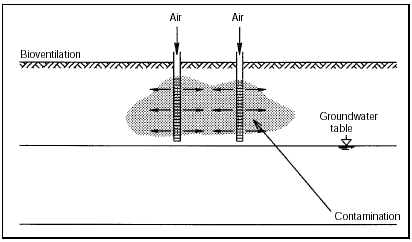
Figure 9.3
Bioventilation
This method is not particularly well documented in Denmark, and the time required for clean-up is still unknown. However, there is no doubt that the method is beneficial as a supplement to, or in combination with, other methods such as soil vapour extraction or groundwater pumping.
9.2.7 Forced leaching
Contaminants are forced to leach by artificially increasing the infiltration of water through the contaminated area, possibly by recirculating abstracted water. It may be beneficial to add nutrients, bacteria, and oxidants to the water to stimulate degradation, or detergents may be added to increase bioaccessibility (detergent leaching).
The leach water is infiltrated, either via leach fields, via sprinklers, or directly into the saturated zone. The leach water will usually be treated water abstracted from the contaminated zone, or uncontaminated water abstracted nearby for the purpose of hydraulic control.
This method works best in combination with other methods, normally remedial pumping. In this case, the abstracted water can be used for leaching after treatment, and hydraulic control is ensured. The method appears to be appropriate for remediation of soluble and bio-degradable contaminants in relatively homogenous, sandy deposits with well-defined hydraulic conditions.
A few projects using this method have been completed /31, 32/. However, detergent leaching is still under trial. It would seem that the mobile components in the contamination are removed relatively rapidly (within months), but total remediation seems to be impossible in practice if this method is used alone. Furthermore, it should be noted that there can be operational problems with this method, and in many cases these have resulted in problems as a consequence of clogged screens, etc. due to precipitation of iron and biological growth. Substances which are added to the infiltration water can give pollution problems, e.g. bacteria, detergents, etc.
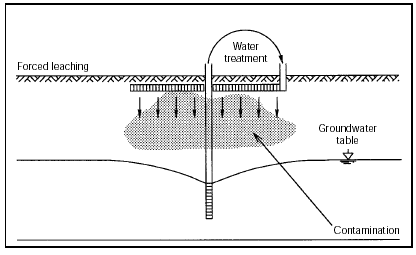
Figure 9.4
Forced leaching
9.2.8 Immobilisation
Instead of removing contamination, it is possible to hold the contamination in place so that the area can be used for specific purposes. In Denmark, constructional methods are often used, e.g. asphalt and paving which prevent surface contact with the soil ensure that the further downward movement of the contamination is minimised.
The contamination may be sealed in by the placement of membranes made of synthetic materials or very low-permeable materials (clay or bentonite). In especially complicated cases of contamination, vertical barriers may be applied to prevent horizontal spreading of the contamination, for example using membranes (in open excavations), sheet piling or vertical barriers of bentonite/concrete bentonite/soil, and slurry walls or drilling techniques (grouting and Deep Soil Mixing). There are therefore many well-tested techniques to contain the contamination using impermeable barriers, as they are based on geotechnical techniques often applied abroad.
Remediation has been executed abroad in a small number of situations using in-situ vitrification, where the soil is heated by an electric current and converted to a glass-like mass. In addition, in-situ stabilisation is often applied in the USA, but has only been tested in a limited number of situations in Denmark /31/. Attempts have been made to reduce leaching by mixing a stabilising agent with the soil (e.g. bentonite, cement, or lime).
For sealing, it is crucial to ensure that the material is impermeable. However, groundwater can still be affected by the contamination as horizontal movement of groundwater in the water-bearing layer occurs independently of rainfall at the site. In addition, diffusion of volatile substances must not be ignored. Therefore, the method is not applicable as the only solution for highly volatile contamination. Emplacement of membranes should be supplemented with systems for collecting and draining precipitation.
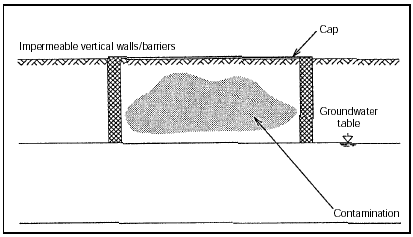
Figure 9.5
Sealing contamination
9.2.9 Bioremediation
In bioremediation, optimal conditions for degrading contamination are created in the soil. This can be done by adding appropriate micro-organisms (inoculation technique) or by improving living conditions for naturally-occurring bacteria (stimulation technique), for example by adding oxygen or detergents (increases biological availability by increasing solubility).
Remedial projects have been started which use the stimulation technique (bioventing, see above), while the inoculation technique is still at the experimental stage in Denmark. In principle, most organic substances can be degraded by micro-organisms, except substances such as PCB, chlorinated dioxins, heavy metals, and high-molecular PAHs. Certain conditions regarding the physical-chemical relationships in the soil matrix must also be fulfilled. These include oxygen content, inorganic nutrient content (e.g. ammonium and phosphate), availability and toxicity of the xenobiotic substances, temperature, and pH. Additionally, water content and soil type are also significant (soil with a high clay content is not appropriate). Tests have generally resulted in heterogeneous and high-concentration residues, and there are also problems with the long duration of the remediation process. This is why biological in-situ inoculation methods are not yet commercially utilised /37, 38/.
9.2.10 Other in-situ methods of soil remediation
Electrokinetic soil remediation removes heavy metals or organic contamination from soil. The technique forces the heavy metals contaminants out of the soil by electrokinetic processes which arise when the soil is subjected to an electric field ( electromigration). Organic contamination can also be removed by electro-osmosis. Pilot tests are currently in progress in Denmark /39/, and the method may have a commercial future for removing heavy metals. Full-scale execution of the methods below has only taken place a very limited number of times abroad and therefore they are not immediately commercially accessible in Denmark.
In steam stripping, the soil is loosened using two counter-rotating drill bits. Steam and compressed air are pumped down through the bits and into the soil. In this way, volatile components are stripped from the soil and evaporate to the surface. The method has not been attractive under Danish conditions, primarily because it is an expensive method which demands a lot of energy. Furthermore, the method requires that objects larger than about 0.3 m are removed from the soil, and that the site does not slope by more than 1 per cent.
Through the infiltration of active substances, contaminated soil is degraded into less toxic substances. This method has not been applied in Denmark as there have not been any pilot-scale trials. The method requires soil with a high permeability. Furthermore, there will probably be problems in cleaning sufficiently to meet specific quality criteria.
The soil is exposed to compressed air via soil borings with a view to increasing the permeability of the soil. The method can be combined with other techniques, e.g. venting. This method has not been utilised in Denmark, primarily because there is no documentation of the applicability of the method.
9.2.11 Running-in soil remediation installations
If soil remediation uses technical installations, this equipment must be run-in once it has been established. For example, in order to optimise air flows, running-in of venting installations typically includes recording amounts of air pumped and pressure measurements in monitor wells. At the same time, a certain number of chemical analyses are taken. Running-in should be concluded with the completion of an operating manual.
Operation includes maintenance of the technical installations, monitoring the amount of contamination, and regular assessment of the equipment and contamination collection. In order to ensure optimal operation, an equipment register, a calendar of activities, descriptions of work, and regular status reports are prepared. Operation and evaluation for individual techniques is described in more detail in Chapter 10.
9.3 Remedial methods for groundwater contamination
9.3.1 Overview of remedial methods
There are various principles and methods for remediation of groundwater contamination. The choice of remedial strategy in a specific situation depends on the following factors:
| Type of contamination (phase distribution, density, etc.) and composition. | |
| Position of the contamination (horizontal and vertical), as well as the contamination’s extent and severity. | |
| Hydrogeological conditions (hydraulic parameters, type of aquifer, hydrological basin, etc. | |
| Time required for remediation. | |
| Site conditions. | |
| Necessity of hydraulic control. | |
| Amount of investment and operating and maintenance costs. |
The most common remedial methods known today are:
| Ordinary pump-and-treat from screened wells. | |
| Separation pumping from specific levels. | |
| Pumping with multiple pumps in several phases. | |
| Skimming LNAPL contamination from screened wells. | |
| Pumping from drainage systems. | |
| Pumping from suction-probe equipment (including ‘bioslurping’). | |
| In-situ methods (including air sparging, adding oxidising agents, reactive walls, vertical barriers). |
9.3.2 Pump-and-treat
Pumping from deeper aquifers is typically performed from screened wells.
In order to bring a contamination under hydraulic control, a pumping strategy must be prepared. A pumping strategy includes the following /40/:
| Location of pump wells | |
| Number of pump wells | |
| Pump yield | |
| Pump levels |
Depending on the situation, a number of different methods are available to fulfil the pumping strategy. These include ordinary pump-and-treat from screened wells, separation pumping, skimming, injection, recirculation, or possibly a combination of methods.
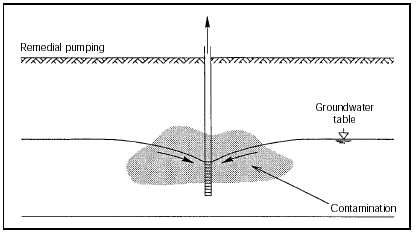
Figure 9.6
Remedial pumping
In cases where contamination consists of a light non-aqueous phase liquid (LNAPL) on the groundwater, it is usual to remove the LNAPL by skimming before alternative remedial methods are started. If a LNAPL e.g. petrol and oil is present, extensive drawdown of the groundwater table should be avoided as this will cause the contamination to smear the exposed soil where it cannot be removed using simple methods. Using several wells with a smaller drawdown, possibly with the aid of vacuum to remove air and water simultaneously, can be the optimal solution in these cases.
In cases where there is groundwater contamination near the ground surface, it is often advantageous to utilise drains connected to a collection sump from which groundwater is pumped. This solution is particularly relevant in connection with excavation, as the method usually requires extensive excavation. Drilling horizontal drains can be a solution in some cases.
Suction-probe equipment may be appropriate for short-duration pumping in sand aquifers near the surface (max. 5-7m delivery head).
Bioslurping is a relatively new method, which in principle is a further development of the suction-probe technique. By using a vacuum, both liquid and air are removed at the same time through an adjustable suction pipe which can be located in conventional wells. The well opening must be sealed to maintain a vacuum.
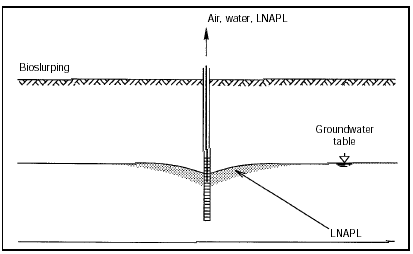
Figure 9.7
Bioslurping
There are various methods which can be used to optimise pumping strategies. The strategy is usually set on the basis of the location of water abstraction wells and their capture zones. The overall groundwater flow direction is normally determined through measuring the potentiometric surface. Through pump tests, the hydraulic parameters of the aquifer, transmissivity, specific yield, and leakage can be determined. Furthermore, the vertical variations in the reservoir can be determined by geophysical logging. By performing conductivity and temperature logging, variations in ion distribution and temperature can be determined, and flow logs determine variations in inflow. In addition, there are a number of logs which provide various geological information on the formation (gamma, electricity, resistivity, and conductivity logs).
With other hydrogeological data and knowledge of the extent and nature of the contamination, these data can be used to determine the optimal pumping strategy. Groundwater flow and contaminant transport models can be used where conditions require information on alternative strategies. There are examples of several types of numerical model which have different applications. Both two and three-dimensional models are available. Today, three-dimensional models are usually used, which can perform both stationary and dynamic simulations of the scenarios desired.
Pump types and technical equipment to control pumping depend on the situation. There are numerous types of pump. Submersible pumps are often used in deeper aquifers, while vacuum pumps and centrifugal pumps are suitable for aquifers close to the surface (up to a depth of about 7m). There are various technical accessories to ensure hydraulic control by maintaining the required groundwater potentials, e.g. level controls, pressure transducers, timers, or electrodes.
Vast experience with the pump-and-treat method has been gained. Many of these cases have now been completed. However, many cases have demonstrated complications in achieving stop criteria, and total remediation up to groundwater criteria is not a realistic goal. On the other hand, using hydraulic control, it is possible to prevent groundwater contamination from spreading towards abstraction wells etc., and at all events, a large amount of the contamination is removed.
Following construction, a running-in phase (implementation) for the remedial installation begins. This phase is aimed at optimising operation. Instructions for running-in the technical equipment are prepared (includes recording electricity consumption, checking pumps, documenting pump yield, documentation of water treatment, etc.). In addition, instructions for contamination removal are prepared (includes recording pump performance, recording water/air quantities, taking water table measurements, analysis programme, and results).
When the running-in phase has been completed, compliance with success criteria is assessed (water table levels, contamination concentrations, etc.). Any necessary changes are then made (technical equipment, pumping strategies, groundwater models, etc.). Operation and evaluation of the pump-and-treat system are described in Chapter 10.
9.3.3 Discharge and treatment of the abstracted groundwater
In some cases, contaminated water can be discharged to the nearest sewage treatment plant or to less-sensitive surface waters. In other cases, water treatment is required before discharge. This requires individual assessment of the situation in question. For discharge directly into sewers, analyses should be carried out to prevent possible damage to the treatment plant. In addition to the type and concentration of contamination, water quantities and content of organic matter are crucial factors in determining whether discharge into the sewage system is possible. At the same time, assessments must be made as to whether discharge can present problems for the work environment of sewage workers.
Prior to discharge to sewage treatment plants, authorisation must be obtained from the supervisory authority for the sewage treatment plant in question. The supervisory authority will determine whether the plant is able to accept the water. If there are problems in accepting the amounts of water, it may be possible to discharge the water at night when the other demands on the plant are usually low. Significant sewage expenditure must be expected for discharge into sewers. Expenses can vary from local authority to local authority.
Treatment may be required before discharging contaminated groundwater to sewers, a surface water recipient, or a reservoir. The method of water treatment used depends on the contaminant in question as well as water quantities and quality requirements. Therefore, these methods must be assessed individually for each specific case. There is a distinction between on-site treatment, where the abstracted groundwater is treated using equipment placed on the contaminated site, and in-situ treatment where the groundwater is treated in the aquifer without being pumped. The following on-site treatment principles are generally recognised and accepted for remediation of contaminated groundwater. For special problems, please refer to the Soil Project on land use and remediation of contaminated groundwater /41/. Appendix 9.1 provides examples of costs of the different water treatment methods.
Gravimetric separation of contamination from pumped groundwater has long been applied in oil/petrol contamination. Traditional oil-water separators, however, often have limited effectiveness in that residual concentrations can be as high as 100 mg of oil product per litre at the outlet /41/. A further development is the coalescence separator where a built-in synthetic material gathers the small drops of oil into larger drops which rise up to the surface of the water. In this way, removal effectiveness is significantly improved with residual concentrations as low as 20 mg of oil product per litre.
If the pumped water contains stable emulsions and high concentrations of dissolved components, equipment for destroying the emulsion can be used. Chemicals are added and the effect which is achieved, depends on dosage and residence time. This system requires a greater degree of on-going evaluation during operation. The reader is referred to more detailed rules regarding the type and functional requirements for discharge systems with separators in DS 432 "Norm for discharge installations" /42/.
Treatment of water by using filters is a prevalent and well-documented method. The choice of filter material depends on the specific contamination situation. Traditional sand filters are widely used as pre-treatment for the removal of iron, manganese and ammonium prior to special processes, but are also used for the biological degradation of organic contamination. Pre-treatment for iron and manganese removal should always be considered in water treatment as this is often a prerequisite for the subsequent special processes can be carried out as intended.
Membrane filtering is carried out by pressing water through a semi-permeable membrane which retains molecules larger than the water molecule. This method is used for removal of salts and heavy metals /41/. Adsorption filtration with activated carbon as the adsorbent is a widespread method for removal of all types of organic contaminants.
All of these filter technologies have a common need for backwashing and/or cleaning of the filter material and occasional replacement. The effect of the filter is reduced with time as the filter material slowly looses its ability to absorb/adsorb the contaminants or is clogged. Therefore, considerable operational expenses should be expected in connection with filter cleaning, backwashing and/or replacement.
For volatile organic contaminants, a process where contaminants are transferred from the water to the air of the stripping system may be used. The effectiveness of this process depends primarily on the design of the system and the contaminant’s vapour pressure and water solubility /41/.
In photochemical oxidation, hydrogen peroxide and/or ozone is activated by ultraviolet radiation. In this manner, substances that provide a strongly oxidising environment and destroy the contaminants are formed. The products of degradation are water, carbon dioxide and volatile easily degradable organic acids. The method is useful for destroying most types of organic contaminants, such as benzene, mineral oil products, solvents, pesticides and cyanides /41/. The effectiveness depends on the residence time of the contaminant in front of the UV light. This residence time can be varied, depending on the discharge requirements.
Biological treatment of oil products is well-known from sewage treatment plants. In Denmark, there are only a few good experiences with on-site biological treatment of contaminated groundwater. Variations in the concentration level and temperature, degradation rates and stability are all factors which make the operation of small treatment units very difficult to optimise.
9.3.4 In-situ remediation methods for contaminated groundwater
Air sparging has recently begun to be used in Denmark. Air sparging implies physical removal and microbial degradation of contamination in the groundwater by blowing, for example, atmospheric air below the groundwater table. Air is blown below the groundwater table so that volatile components are stripped and transferred from the water phase to the unsaturated zone, where they must be removed using other techniques. Furthermore, microbial decomposition in the groundwater zone is stimulated because of the added oxygen.
Only a few completed air-sparging remediations are known (1997), but the method is considered to have a future in Denmark if it is combined with other methods, e.g. soil vapour extraction for organic volatile contamination under homogenous geological conditions. The geology is a decisive factor in that a reasonable amount of homogeneity in the media is required. This is particularly important for remediating chlorinated solvents since stripping is the only removal mechanism.
In order to determine whether a site is appropriate for this method, and to design the system, a well-designed pilot test should be conducted in the form of air-sparging/tracer tests in the reservoir where the system is to be installed /32, 43/.
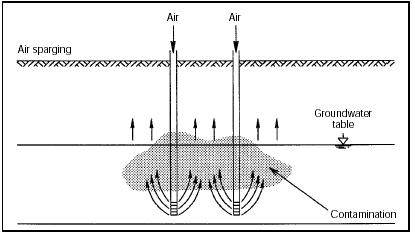
Figure 9.8
Air Sparging
A related method, developed from air sparging, is biosparging. In this method, the primary objective is to stimulate the biological process. Here, the oxidising agent is added in pulses under lower pressures.
A new method, which was first used in remediations in Denmark in 1997, is to add the oxidising agent or Oxygen Release Compound (ORC) to the groundwater zone. The method is relatively new in the USA, but it has become very successful over a short period. The method is inexpensive and environmentally friendly, and it will probably become widespread in Denmark.
It is possible to cut-off groundwater contamination by establishing vertical barriers in the groundwater aquifer. This can be done using various methods such as sheet piling, excavation methods, slurry walls, drilling methods, deep soil mixing (DSM) and grouting. The different methods use different materials for the barriers such as betonite, and possibly in combination with different types of plastic panels (geo-membranes). The methods have been applied at many sites abroad, but have yet to be used in Denmark. It is necessary to be aware of the physics and location of the contamination, as well as possible problems with groundwater backing up. Therefore, it can be beneficial to construct barriers in the form of a funnel leading to a permeable gate (funnel and gate technique) where a reactive permeable barrier can be constructed in the gate area /44/.
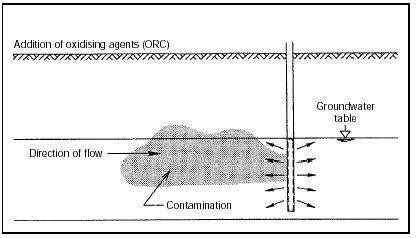
Figure 9.9
Addition of oxidising agents
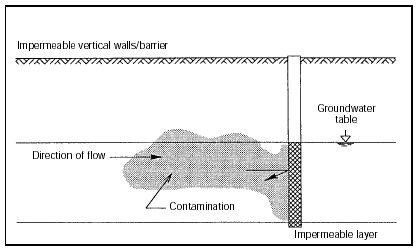
Figure 9.10
Impermeable cut-off walls
Reactive permeable walls are barriers which allow the passage of groundwater, but which degrade or remove contamination from groundwater during the passage. The method is at an experimental stage in Denmark, but it is used in the field in the USA for degrading chlorinated compounds with iron filings as the reactive material in the barrier. In addition, materials can be used with particularly high sorption properties, e.g. clay minerals or active carbon. The barriers may be disposable or reusable modules. This method may have a future in Denmark.
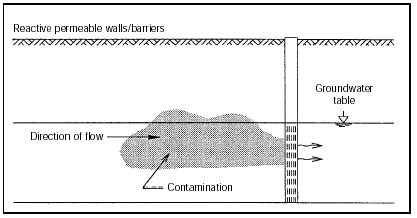
Figure 9.11
Reactive permeable walls
9.4 Remedial methods for contaminated soil gas
9.4.1 Buildings on contaminated areas
As far as possible, construction of new buildings should be should be planned so that they are not located on contaminated areas, as this can create obstacles to a subsequent remediation. Land use should be planned so that contaminated areas are not used for very sensitive land uses. The environmental authorities can, however, allow contaminated sites to be used for specific purposes without requiring total remediation. All new construction, including construction on contaminated sites, must be conducted according to the guidelines on radon in new construction from the National Housing and Building Agency /14/.
In existing buildings with unsatisfactory concentrations of contaminants with respect to health which stem from contaminated soil, a practical solution is often improved ventilation in crawl spaces, the gravel drainage layer under floors or in cellars, although it should be noted that strong ventilation in cellars may increase convection of volatile xenobiotic substances through cracks and leaks.
In outdoor areas which are frequented by people, there should be protection from exposure to contamination, primarily from dust from contamination near the surface, and more rarely from evaporation of volatile contamination. In many cases, the area can be sealed with a cover such as asphalt or possibly by replacing the upper layer of soil, depending on the situation.
9.4.2 Construction technology measures
In order to prevent volatile contamination from being transported up in buildings, there are various options for ventilating gravel drainage layers under floors, cellars, or basements. Moreover, ventilation generally can be improved in rooms. For ventilation drains, drainpipes are laid out in, for example, the gravel capillary-breaking layer under floors. Ventilation pipes are connected to a collection well where a ventilator may be installed, if this later proves necessary. Ventilation pipes may also provide passive ventilation and should therefore be extended over the ground surface with possibilities for venting into the free air. In planning new buildings, natural air renewal can be used by constructing crawl spaces or elevating the buildings.
Ventilation is a very widespread method, and is usually adequate for most contamination types. Ventilation solutions are easy to include in construction projects and are also inexpensive to install. Experience also shows that it is often not necessary to commence active ventilation since passive ventilation is usually sufficient.
As a supplement or possible alternative to ventilation solutions, diffusion-inhibiting synthetic membranes may be laid out. There are different products which may be used, depending on the contamination. It must be ensured that the membrane is appropriately welded, and that it stops the contamination in question.
Transport of contamination into the building can also be prevented if the choice of materials includes reinforced-concrete foundations and floors of at least ‘moderate environmental quality’.
9.5 Remedial methods for landfill gas
If there is a health/safety risk for occupants in a building on or near a landfill, remedial measures should be carried out so that landfill gas is prevented from reaching the buildings, or so that concentrations do not exceed acceptable levels and/or so that an early warning is given by gas alarms.
The objectives of remedial measures for landfill gas are to ensure that methane does not present risks of explosion, and that carbon dioxide does not present a toxicological risk. This is achieved by checking gas flows and thereby ensuring that the gas does not flow towards the buildings, but is led away from the critical area.
As with all other contamination, new construction should be located outside the risk area, if possible. For more detailed considerations, refer to Report No. 69 on landfill gas from the Danish Environmental Protection Agency /17/.
Remedial measures can include various principles. The following methods are used to prevent the flow of gas towards buildings.
| Gas barriers (constructed between the source of gas and the building, and normally comprising a gas-tight cut-off membrane placed in a ditch on the side of the ditch that is closest to the building. Synthetic and natural membranes are used). | |
| Permeable ditches (established between the source of gas and the building, and normally comprising a cut-off ditch with coarse material and possibly a gas-tight membrane in the side of the ditch closest to the building. The gas is vented either passively or actively (in drains)). | |
| Venting drains (the gas is vented between the building and the source of gas either passively or actively). | |
| Venting wells (the gas is vented between the building and the source of gas either passively or actively). |
The following methods are used to prevent gas from entering into buildings.
| Sealing buildings (the building is sealed against gas convection, for example by using membranes and sealing cracks in concrete). | |
| Changing the pressure gradients (e.g. buildings can be slightly pressurised above atmospheric pressure). This method is not recommended, however, for buildings which are damp. | |
| Ventilated drains (drains under the building are ventilated on the same principle as used for preventing other volatile contamination described in Section 9.4.2, or ventilation is established around the buildings and in dead space and sewers. The system can work either actively or passively). |
Furthermore, as an extra safety measure in risk areas, systems should be established for monitoring the concentration of gas, and gas alarms should be installed to ensure the effectiveness of remedial measures, as well as to prevent possible injury to people. The monitoring system could start ventilation if high gas levels are measured.
The choice of method depends on the specific situation, and usually a combination of several methods is possible. The location of the contamination in relation to the building is crucial to the choice of method. If the building is located outside the landfill, the problem can often be solved by preventing gas migration to the building, possibly using drains. If the building is located directly on the landfill, construction methods must be used (to prevent entry of gas into the building).
There are both active (ventilators) and passive (natural ventilation) systems. The main rule is that ditches usually function passively, while wells must usually have active ventilation installed to ensure that an adequate radius is affected.
9.6 Residual contamination under houses
If there are strong reasons for leaving residual contamination because it is impossible to remove, a risk assessment of the residual contamination should be performed before decisions are taken, cf. Section 5.2. This should always be followed by administrative regulation so that inappropriate spreading is avoided.
In a project on residual contamination under houses /45/ some suggestions are provided on how contamination under houses can be managed, including which remedial measures are appropriate.